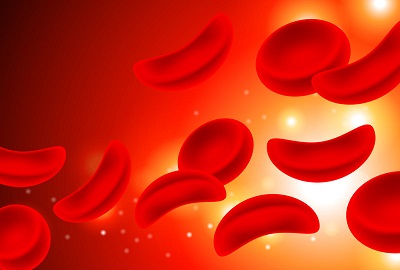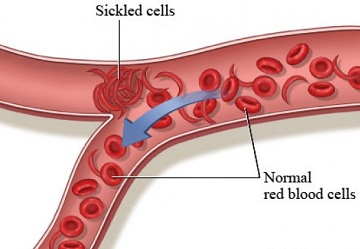Millions of people around the world suffer from sickle cell disease, but it's more common in people with African bloodline. It is also quite common in people whose ancestors come from the Arabian Peninsula; Mediterranean countries such as Turkey, Greece, and Italy; Central America; Spanish-speaking regions in South America; and parts of the Caribbean. It is also the most common blood disorder in the U.S. with every 1 in 500 African Americans and 1 in 1,000 Hispanic Americans suffering from it. As a whole, it affects 70,000 to 80,000 Americans, and is the leading cause of concern for the entire nation.

What Is Sickle Cell Disease?
Sickle cell is an inherited blood disorder in which the red blood cells change their shape. The red blood cells have a disc-like shape, but in patients of sickle cell disease, they take on a crescent or sickle shape. Normal blood cells carry oxygen to the body, but altered cells cannot move easily through your blood vessels, which affects the oxygen supply. It is not easy to live with sickle cell disease and life is in a state of battle all the time. But proper knowledge about the condition will help you live a good life.

Causes of Sickle Cell Disease
Sickle cell disease or sickle cell anemia is a genetic abnormality and is caused by an abnormal type of hemoglobin, called hemoglobin S or sickle hemoglobin. These altered cells cannot carry oxygen properly because when they release oxygen, it sticks together and changes the shape of the red blood cell.
It is important to mention that sickle cell disease is not contagious – you're born with it. A child may have this disease when he/she inherits one hemoglobin gene from each parent. More than 2,000 babies in the US inherit these cells from their parents and get into a lifelong battle. If you inherit only one sickle hemoglobin gene, you may not have anemia, but you are more likely to suffer from conditions such as urinary tract infections or blood in the urine.
Symptoms and Treatments of Sickle Cell Disease
1. Anemia
Your baby may have this condition if he/she lacks the number of healthy blood cells required to carry sufficient oxygen to the rest of the body. Some of the most common symptoms include paleness, low energy, breathing problems, and slower growth.
Treatment: The doctor will consider the severity of the symptoms to suggest a treatment plan, but they may rely on antibiotics and blood transfusion to treat the condition.
2. Acute Chest Syndrome
It could be an extremely painful and serious situation because it restricts blood flow to the lungs. Some common signs and symptoms include chest pain, breathing problems, and fever.
Treatment: The doctor may recommend treatment with blood transfusions, antibiotic medicine, pain medicine, and oxygen to help improve breathing.
3. Pain
Pains are common and happen when sickle cells restrict blood flow. Pain can be anywhere in the body – it can be in organs and joints as well. The pain may continue for a few hours or extend to days and even weeks. It is important to give your child plenty of fluids, maintain temperature, and keep them from high altitudes to limit pain episodes.
Treatment: Some of the most common treatment options include heating pads, prescription pain medicine, OTC pain relievers like ibuprofen, and hydroxyurea to help produce a specific type of hemoglobin.
4. Hand-Foot Syndrome
A child may experience pain, coldness, or swelling in the feet and hands when the sickle cells affect the blood supply to these limbs.
Treatment: The doctor may rely on certain pain-relieving medicine to treat the symptoms. Giving your child plenty of fluids may also help.
5. Splenic Crisis
Sometimes, sickle cells accumulate in the spleen and clog it. This leads to swelling that prevents the spleen from filtering blood in the body. Specific signs include weakness, pain on the left side of the belly, and a rapid heart rate.
Treatment: The usual treatment option is blood transfusion. The doctor may also consider removing the spleen if splenic crisis becomes a regular issue.
6. Infection
Your child may have to fight with several infections including the infection of the lining of the brain and lung infection. Signs and symptoms include breathing problems, fever, coughing, headaches, and pain in the bones.
Treatment: It is important to prevent an infection from happening by staying up to date on vaccinations. If your child gets an infection, your doctor may recommend some antibiotics to clear the infection. Taking antibiotics regularly may help prevent infections when your baby is between 2 months and 5 years of age.
7. Stroke
Those altered red blood cells may restrict blood flow to the brain, which sometimes leads to a stroke. The most common symptoms include weakness on one side of the body, severe headache, and changes in speech, alertness, hearing, or vision.
Treatment: Your child's healthcare provider will first notice these symptoms and then ask for an ultrasound, called Doppler ultrasound, to determine your child's risk for stroke.
8. Vision Loss
Blindness and other vision problems may happen when these cells block blood supply to your child's eyes. Sometimes, the cells block the blood flow to a specific part of the brain that leads to vision loss.
Treatment: Regular eye exam is necessary to avoid such issues, but your doctor may also recommend laser eye treatment to prevent further damage.
Can Sickle Cell Disease Get Cured?
Unfortunately, there is no real cure for sickle cell disease. However, some children have seen positive results from stem cell transplant. Found in bone marrow, stem cells act together to make a repair system for the body. Stem cells are also present in umbilical cord blood and placenta. During the transplant, the surgeon will put stem cells into the body of a sickle cell disease patient. The procedure is extremely risky and often leads to life-threatening side effects. Be sure to discuss all the implications with the doctor before you decide to take stem cell transplant.
If you want more information about sickle cell disease's causes, symptoms and how to deal with it, learn more with Dr. Freda Lewis-Hall and Tionne "T-Boz" Watkins: